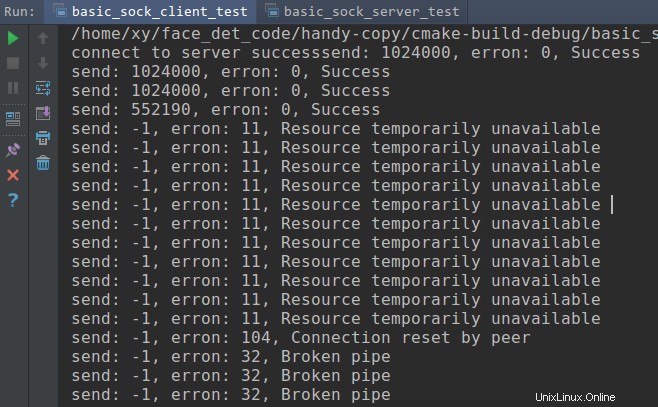"Resource temporarily unavailable" è il messaggio di errore corrispondente a EAGAIN , il che significa che l'operazione sarebbe stata bloccata ma è stata richiesta un'operazione non bloccante. Per send() , che potrebbe essere dovuto a uno qualsiasi di:
- contrassegnare esplicitamente il descrittore di file come non bloccante con
fcntl(); o - superando il
MSG_DONTWAITflag asend(); o - impostando un timeout di invio con il
SO_SNDTIMEOopzione socket.
Facciamo un esempio:
-
il client si connette al server e invia 1 MB di dati al server ogni secondo.
-
il lato server accetta una connessione, quindi dorme 20 secondi, senza ricevere messaggi dal client. Quindi il
tcp send buffernel lato client sarà pieno.
Codice lato client:
#include <arpa/inet.h>
#include <sys/socket.h>
#include <stdio.h>
#include <errno.h>
#include <fcntl.h>
#include <stdlib.h>
#include <string.h>
#define exit_if(r, ...) \
if (r) { \
printf(__VA_ARGS__); \
printf("%s:%d error no: %d error msg %s\n", __FILE__, __LINE__, errno, strerror(errno)); \
exit(1); \
}
void setNonBlock(int fd) {
int flags = fcntl(fd, F_GETFL, 0);
exit_if(flags < 0, "fcntl failed");
int r = fcntl(fd, F_SETFL, flags | O_NONBLOCK);
exit_if(r < 0, "fcntl failed");
}
void test_full_sock_buf_1(){
short port = 8000;
struct sockaddr_in addr;
memset(&addr, 0, sizeof addr);
addr.sin_family = AF_INET;
addr.sin_port = htons(port);
addr.sin_addr.s_addr = INADDR_ANY;
int fd = socket(AF_INET, SOCK_STREAM, 0);
exit_if(fd<0, "create socket error");
int ret = connect(fd, (struct sockaddr *) &addr, sizeof(struct sockaddr));
exit_if(ret<0, "connect to server error");
setNonBlock(fd);
printf("connect to server success");
const int LEN = 1024 * 1000;
char msg[LEN]; // 1MB data
memset(msg, 'a', LEN);
for (int i = 0; i < 1000; ++i) {
int len = send(fd, msg, LEN, 0);
printf("send: %d, erron: %d, %s \n", len, errno, strerror(errno));
sleep(1);
}
}
int main(){
test_full_sock_buf_1();
return 0;
}
Codice lato server:
#include <arpa/inet.h>
#include <sys/socket.h>
#include <stdio.h>
#include <errno.h>
#include <fcntl.h>
#include <stdlib.h>
#include <string.h>
#define exit_if(r, ...) \
if (r) { \
printf(__VA_ARGS__); \
printf("%s:%d error no: %d error msg %s\n", __FILE__, __LINE__, errno, strerror(errno)); \
exit(1); \
}
void test_full_sock_buf_1(){
int listenfd = socket(AF_INET, SOCK_STREAM, 0);
exit_if(listenfd<0, "create socket error");
short port = 8000;
struct sockaddr_in addr;
memset(&addr, 0, sizeof addr);
addr.sin_family = AF_INET;
addr.sin_port = htons(port);
addr.sin_addr.s_addr = INADDR_ANY;
int r = ::bind(listenfd, (struct sockaddr *) &addr, sizeof(struct sockaddr));
exit_if(r<0, "bind socket error");
r = listen(listenfd, 100);
exit_if(r<0, "listen socket error");
struct sockaddr_in raddr;
socklen_t rsz = sizeof(raddr);
int cfd = accept(listenfd, (struct sockaddr *) &raddr, &rsz);
exit_if(cfd<0, "accept socket error");
sockaddr_in peer;
socklen_t alen = sizeof(peer);
getpeername(cfd, (sockaddr *) &peer, &alen);
printf("accept a connection from %s:%d\n", inet_ntoa(peer.sin_addr), ntohs(peer.sin_port));
printf("but now I will sleep 15 second, then exit");
sleep(15);
}
Avvia lato server, quindi avvia lato client.
il lato server può restituire:
accept a connection from 127.0.0.1:35764
but now I will sleep 15 second, then exit
Process finished with exit code 0

il lato client può restituire:
connect to server successsend: 1024000, erron: 0, Success
send: 1024000, erron: 0, Success
send: 1024000, erron: 0, Success
send: 552190, erron: 0, Success
send: -1, erron: 11, Resource temporarily unavailable
send: -1, erron: 11, Resource temporarily unavailable
send: -1, erron: 11, Resource temporarily unavailable
send: -1, erron: 11, Resource temporarily unavailable
send: -1, erron: 11, Resource temporarily unavailable
send: -1, erron: 11, Resource temporarily unavailable
send: -1, erron: 11, Resource temporarily unavailable
send: -1, erron: 11, Resource temporarily unavailable
send: -1, erron: 11, Resource temporarily unavailable
send: -1, erron: 11, Resource temporarily unavailable
send: -1, erron: 11, Resource temporarily unavailable
send: -1, erron: 104, Connection reset by peer
send: -1, erron: 32, Broken pipe
send: -1, erron: 32, Broken pipe
send: -1, erron: 32, Broken pipe
send: -1, erron: 32, Broken pipe
send: -1, erron: 32, Broken pipe

Puoi vedere, poiché il lato server non riceve i dati dal client, quindi quando il lato client tcp buffer si riempie, ma invii comunque dati, quindi potresti ottenere Resource temporarily unavailable errore.
Questo perché stai usando un non-blocking socket e il buffer di output è pieno.
Dal send() pagina man
When the message does not fit into the send buffer of the socket,
send() normally blocks, unless the socket has been placed in non-block-
ing I/O mode. In non-blocking mode it would return EAGAIN in this
case.
ANCORA è il codice di errore legato a "Risorsa temporaneamente non disponibile"
Prendi in considerazione l'utilizzo di select() per ottenere un migliore controllo di questi comportamenti